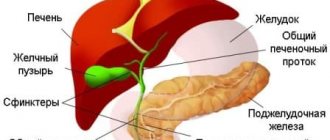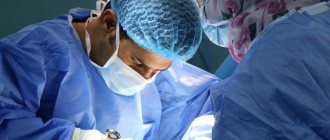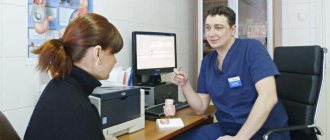Postcholecystectomy syndrome (PCES) is not the most common phenomenon in gastroenterology. It is generally accepted that PCES belongs to the group of gallbladder diseases. In fact, this is not even a disease, but a collective name for a set of symptoms that appear immediately or shortly after surgery on the bile ducts or removal (resection) of the gallbladder.
Until now, both therapists and surgeons find it difficult to clearly determine the causes of the development of this syndrome. Doctors tend to use the term PCES only to make a preliminary diagnosis in operated patients1.
Symptoms of postcholecystectomy syndrome
At its core, PCES is a consequence of surgery for resection (removal) of the gallbladder. This means that after resection the patient may experience unpleasant symptoms, such as:
- dyspepsia or disruption of the normal functioning of the stomach, manifested in the form of bitterness in the mouth, nausea, bloating and intestinal upset;
- pain in the right hypochondrium with transition to the right collarbone or shoulder. The intensity of pain can vary, from unexpressed aching to acute burning;
- general weakness, pale skin (appears against the background of poor absorption of food and developing vitamin deficiency).
With PCES, other symptoms are possible due to exacerbated diseases:
- exacerbation of cholangitis - inflammation of the bile ducts - is expressed in a long-lasting temperature in the range of 37.1-38.0 ° C;
- Cholestasis (stagnation of bile in the liver tissue) can cause severe jaundice2.
Reasons for the development of postcholecystectomy syndrome
The causes of postcholicystectomy syndrome and its development are often associated with disruption of the normal functioning of the sphincter of Oddi (orbicularis muscle). The sphincter of Oddi is a smooth muscle that is located in the lower part of the duodenum and is responsible for regulating the supply of bile and pancreatic juice to the duodenum3.
If we consider that PCES most often affects patients who have undergone surgery to remove the gallbladder4, then the mechanism of occurrence of this syndrome can be explained as follows:
- after the operation, the sphincter, which normally opens when the gallbladder is full, does not receive a signal about filling, as a result of which it is almost constantly under tension;
- due to the absence of a bladder, bile enters the duodenum in a diluted state, which increases the pressure inside the intestinal walls. In addition, bile itself has a bactericidal effect and a change in its composition can lead to intestinal infection5.
But sphincter of Oddi dysfunction may not always be caused by removal of the gallbladder. Sometimes the cause of the syndrome is advanced gastrointestinal diseases* (chronic colitis or gastritis, peptic ulcer) and chronic pancreatitis) - a disease of the pancreas, as well as errors in preoperative examination.
“Fuzzy head” is one of the main signs of astheno-neurotic syndrome
If “fuzzy head”, “cloudy head” is the feeling with which you get up and lie down, and if increased irritability, fatigue and poor sleep are added to this, most likely we are talking about astheno-neurotic syndrome
.
Main symptoms:
Many people complain of “fog in the head”, “head like cotton wool”, “fuzzy head” and similar symptoms.
If you notice fatigue, sleep disturbances, and constant irritability, then you may have a mental disorder called astheno-neurotic syndrome.
Prevalence:
This disease is one of the most common “diseases of civilization.” It is often called "managers' flu."
Educated and successful people are susceptible to the disease. The most typical age is from 20 to 40 years. These are entrepreneurs, managers, doctors, teachers. People whose work involves increased responsibility, such as air traffic controllers, are at particular risk.
In the past, astheno-neurotic syndrome was called “nervous exhaustion”
Creative individuals are also at risk.
Causes:
The main causes are stress, prolonged nervous excitement, chronic lack of sleep, and constant overwork. Also factors contributing to the occurrence of astheno-neurotic syndrome are previous diseases, including colds, some viruses, poisoning, and poor environmental conditions.
Similar symptoms:
What diseases can manifest themselves as “foggy head”, poor sleep, weakness and irritability, except neurasthenia? First of all, these are asthenic conditions with the onset of serious illnesses. The second is masked depression, which at the beginning can easily be confused with astheno-neurotic syndrome. And chronic fatigue syndrome can manifest itself in a similar way.
So only a psychotherapist or psychiatrist can make a correct diagnosis. To make a diagnosis, professional psychological diagnostics (psychotests) are usually used, which you can take yourself (follow this link).
How the disease develops:
The syndrome occurs gradually, with a combination of emotional and physical stress, constant fatigue. Most often, patients complain of loss of strength, general weakness, increased irritability, “fog” in the head, and inability to cope with normal amounts of work.
If a person continues to be exposed to stress and does not seek medical help, his condition worsens - the usual set of complaints about a “cotton” head is joined by tearfulness, complaints about the heart, and fog in the head. Irritability increases to an extreme degree, but irritation quickly gives way to weakness. Sleep is usually unstable, does not bring a feeling of rest, and after sleep the head feels like cotton wool. Appetite worsens, constipation or diarrhea may bother you. Sexual desire decreases in both men and women. The condition worsens before a change in weather (so-called “meteosensitivity”). In the absence of treatment at this stage, apathy, lethargy, severe weakness and persistent depression of mood are further added. Interest in life decreases, the patient thinks only about his painful condition, about his “fuzzy” head.
Left untreated, psychotic disorders may develop.
Treatment:
The prospects for treatment are positive; usually psychotherapeutic methods give excellent results, including complete recovery. In severe cases, a combination of psychotherapy and psychopharmacotherapy is used.
Self-medication usually worsens the condition and leads to progression of the disease.
At the initial stage of the disease, in order to make a correct diagnosis, a psychotherapist needs to exclude all diseases that exhibit similar symptoms, because the more accurate the diagnosis, the more successful the treatment will be.
Different diseases with similar symptoms must be treated differently. Therefore, you should definitely consult a psychotherapist. A good psychotherapist selects therapy that matches the specific manifestations of the disease and the individual characteristics of each patient.
Astheno-neurotic syndrome is one of the most common “diseases of civilization.” It is often called "managers' flu."
Treatment of the syndrome depends on the severity of painful symptoms, but is primarily aimed at eliminating psychotraumatic factors. It is necessary to reduce both mental and physical stress. This is the most important condition for treatment; without such measures it will not be possible to defeat the disease. In the early stages of the disease, normalizing the rhythm of life, eliminating stress and psychotherapy may be enough to significantly improve health. And, of course, at this stage, psychotherapy methods that do not use drugs - cognitive-behavioral, psychoanalysis - have a very good effect, and group psychotherapy methods are very effective.
In any case, you need to see a psychotherapist.
In more advanced cases, additional psychopharmacotherapy may be required. General strengthening drugs, tranquilizers, and, if necessary, sleeping pills and antidepressants are used. Psychotherapy is also actively used in the treatment of advanced astheno-neurotic syndrome.
The first indicator of improvement is the normalization of sleep and the disappearance of the feeling of “fog” in the head. With timely treatment, the problem can usually be completely overcome, however, if the tense environment and stress at work and in personal life continue to persist, various complications are possible.
Terminology and other names:
In the past, astheno-neurotic syndrome, together with diseases of similar symptoms, was called “nervous exhaustion.”
In modern psychiatry, the term “neurasthenia” is more often used to refer to neuro-asthenic syndrome (synonyms). In the everyday sense, neurasthenia is usually perceived as a painful, nervous, unbalanced state, characteristic of weak-willed people, easily susceptible to various influences and moods, and in a state of acute mental crisis. And in the medical sense, this is a state of depression, irritability, “fuzzy head.”
Diagnosis of postcholicystectomy syndrome
Difficulties in accurately determining the causes that led to the development of PCES and the vagueness of the very definition of the syndrome require a thorough examination of the patient. In order to choose the right treatment, it is necessary to clearly establish what led to the appearance of PCES.
That is why effective diagnosis of postcholicystectomy syndrome includes several methods:
- collection of anamnesis data - the doctor carefully studies old medical reports and records, paying close attention to preoperative diagnostics and the protocol of the operation;
- clinical examination of the patient;
- laboratory tests - clinical and biochemical blood test, stool test for protozoa and worm eggs, general urine test;
- ultrasonography;
- endoscopy of the bile ducts;
- Magnetic resonance imaging or computed tomography of the abdomen6.
1.General information
Shortness of breath (dyspnea) is a deviation of the frequency, depth and/or rhythm of breathing from similar indicators of a healthy person of the same sex and age under the same conditions. Despite some cumbersomeness of this definition, it seems quite complete and accurate. The term “shortness of breath” seems intuitive, which often leads to misunderstandings between the doctor and the patient, who put different meanings into this word.
There are several classifications of shortness of breath:
- inspiratory (on inspiration), expiratory (on exhalation) and mixed (difficulties in both phases of the respiratory act);
- tachypnea (rapid shallow breathing) and bradypnea (slow breathing);
- physiological shortness of breath (transient, reversible intensification of breathing as an adequate adaptive response of the body to stress, injury or objectively low oxygen content in the inhaled air, which requires additional oxygenation) and pathological shortness of breath (caused by airway obstructions, bad habits, cardiovascular failure, obesity, diseases lungs, hematopoietic system, etc.).
This material is devoted to a type of dyspnea called dyspnea at rest (sometimes also called dyspnea at rest). In contrast to the antonymous “shortness of breath on exertion,” which is sometimes difficult to distinguish from the normal physiological response of the respiratory system, resting dyspnea is a much more unfavorable clinical and prognostic sign.
Sign up for a consultation
A must read! Help with hospitalization and treatment!
Treatment of postcholicystectomy syndrome
Since PCES is not an independent disease, treatment of the syndrome is always determined by its causes. Not knowing how to properly treat postcholicystectomy syndrome can only aggravate the condition and increase unpleasant symptoms.
The principles of treatment for PCES include two key points:
- collection of anamnesis data - the doctor carefully studies old medical reports and records, paying close attention to preoperative diagnostics and the protocol of the operation;
- eliminating the causes of the syndrome;
- prevention and treatment of suspected complications.
Treatment is mainly based on:
- diet therapy;
- drug treatment;
- surgery (according to indications)7.
Together with comprehensive treatment, these measures can reduce the severity of symptoms of PCES8.
4.Treatment
Therapy is always aimed at eliminating the underlying disease, or, if its course is chronic, at relieving the main symptoms and achieving high-quality remission. Dyspnea at rest practically never occurs as a single and isolated symptom; Given the sufficient specificity of the associated symptom complexes, the root cause can usually be determined quickly, after which adequate specialized treatment is prescribed.
It is important, however, to repeat: shortness of breath at rest is one of the alarming symptoms, and most often it is a sign (sometimes the first) of a very serious pathology that requires immediate examination and intervention. Therefore, the appearance of this type of respiratory disorder should be a reason for an urgent visit to the doctor.
Sign up for a consultation
The use of enzyme preparations in postcholicystectomy syndrome
In some cases, PCES may be accompanied by disorders of the digestive system. This is due to the fact that food intake becomes a signal for the production of bile and pancreatic enzymes. If the signal does not arrive or arrives intermittently, subsequent events are also disrupted. As a result, food is not processed properly, and the body does not receive enough nutrients. This can affect the general condition of the body and manifest itself as heaviness after eating, discomfort, bloating or diarrhea.
Enzyme preparations have been developed to support digestion; they deliver enzymes from the outside to compensate for their lack in the body. The flagship among such drugs is Creon®.
The drug is available in the form of capsules containing hundreds of small particles - minimicrospheres. They do not exceed 2 mm in size, which is recorded as recommended in world and Russian scientific works9,10. The small particle size allows Creon® to recreate the digestive process as it was intended in the body, and thereby cope with unpleasant symptoms. Dosages of the drug are usually selected by a doctor, however, in accordance with modern recommendations, the starting dosage is considered to be 25,000 units10.
To learn more
An important stage in the treatment of PCES is enzyme therapy, because In many cases of PCES, pancreatic function is impaired and enzyme deficiency occurs11. Because of this, digestive problems arise, manifested in the form of unpleasant symptoms such as abdominal pain, heaviness in the stomach, flatulence and diarrhea. In addition, the lack of enzymes affects the quality absorption of nutrients: the body does not receive the necessary vitamins and minerals.
Creon® is a modern enzyme preparation that replenishes the deficiency of its own enzymes and promotes better absorption of food and improved digestion. More information about the drug can be found here.









